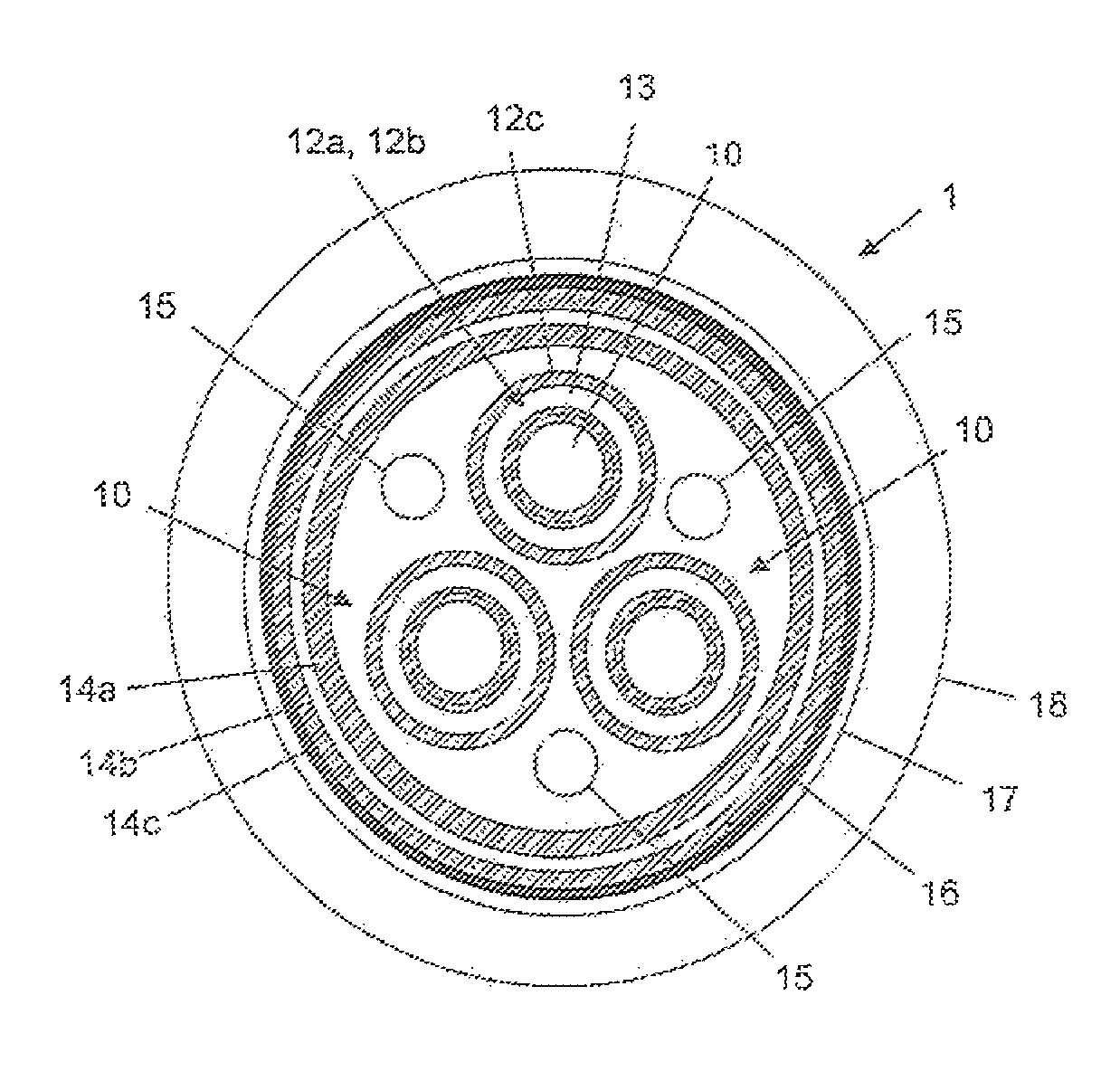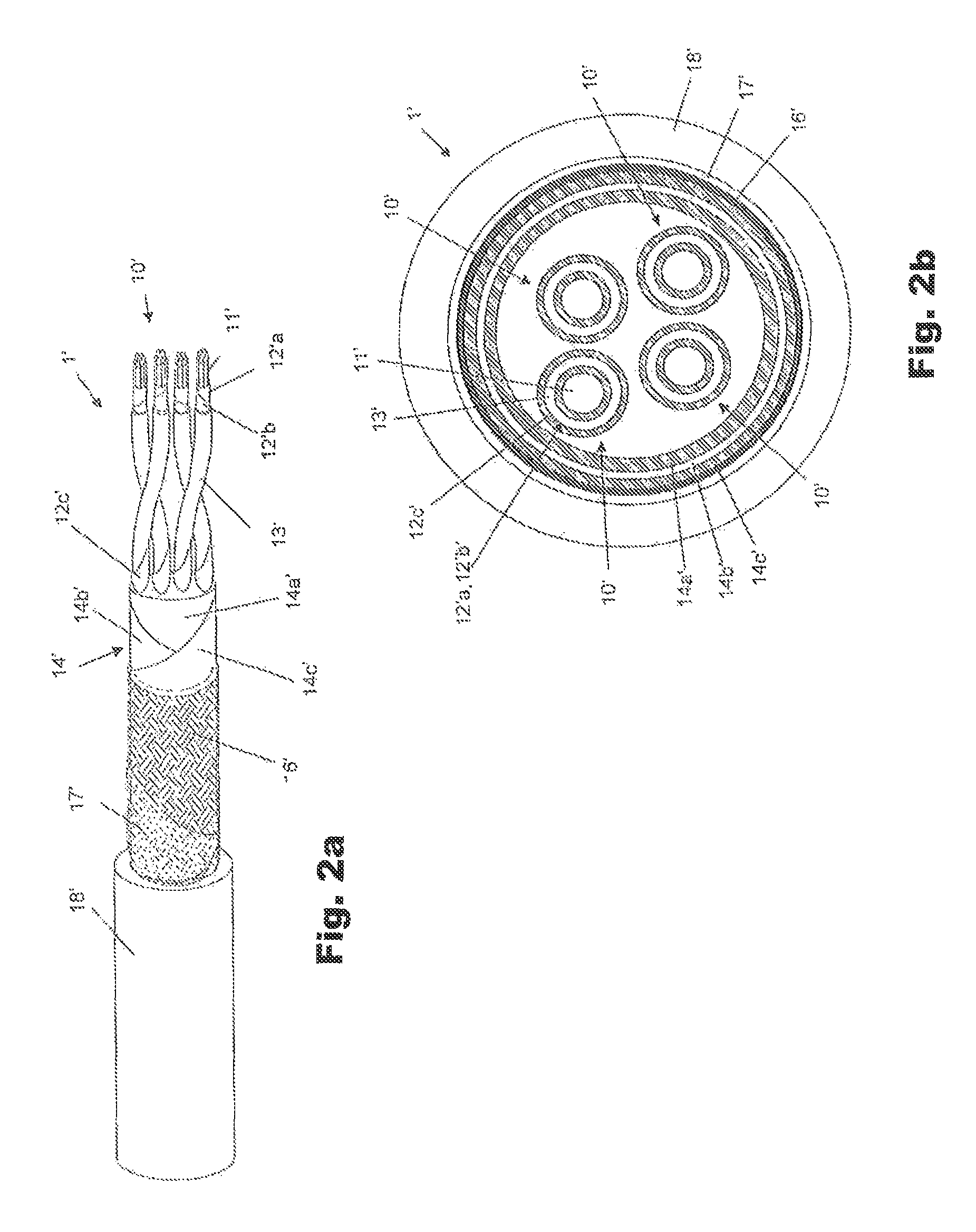Electrical cable resistant to fire, water and mechanical stresses
a technology of electrical cables and insulating layers, applied in the direction of cables, insulated conductors, conductors, etc., can solve the problems of excessive intensity, insufficient protection of mechanical stresses by copper strips and glass fibre strips, and softening of the elastomeric insulating layer, so as to hinder the slight expansion of the ceramifying polymer, increase its own volume, and inhibit the propagation of fumes
- Summary
- Abstract
- Description
- Claims
- Application Information
AI Technical Summary
Benefits of technology
Problems solved by technology
Method used
Image
Examples
first embodiment
[0050]FIGS. 1a and 1b show a low-voltage electrical cable 1 according to the present invention.
[0051]The electrical cable 1 preferably comprises one or more conductors, for example three conductors 10. Each conductor 10 comprises a plurality of metal wires 11, made of copper or tinned annealed copper. The conductor 10 may be, for example, a Class 2 or Class 5 conductor as defined in the IEC 60228 standard, 3rd edition, 2004-11.
[0052]Around each conductor 10 an insulating coating formed by one or more layers of material which is non-thermally-collapsible up to a temperature of, for example, 1050° C. is provided.
[0053]In the case of the cable 1 of FIG. 1a, the insulating coating of each conductor 10 comprises two discontinuous layers 12a, 12b of inorganic insulating material, for example glass fibre and / or mica. The discontinuous layers 12a, 12b are preferably each in the form of a tape wound on the conductor 10. Advantageously, each of these tapes is wound with an overlap equal to or...
second embodiment
[0069]FIGS. 2a and 2b show a low-voltage electrical cable 1′ according to the present invention.
[0070]The electrical cable 1′ preferably comprises one or more pairs of conductors, for example two pairs of conductors 10′.
[0071]Each conductor 10′ preferably comprises a plurality 11′ of metal wires, made of copper or tinned annealed copper. The conductor 10′ may be, for example, a Class 2 or Class 5 conductor as defined by the IEC 60228 standard, 3rd edition, 2004-11.
[0072]Each conductor 10′ is enclosed by an insulating coating formed by one or more materials which are non-thermally-collapsible up to a temperature of 1050° C., for example.
[0073]The insulating coating of each conductor 10′ is substantially similar, in respect of layers and materials, to the insulating coating of the conductors 10 of the electrical cable 1 shown in FIGS. 1a and 1b; that is, it comprises two discontinuous layers 12′a, 12′b of inorganic insulating material, a layer of ceramifying polymer 13′, and, optional...
PUM
| Property | Measurement | Unit |
|---|---|---|
| temperatures | aaaaa | aaaaa |
| temperature | aaaaa | aaaaa |
| temperatures | aaaaa | aaaaa |
Abstract
Description
Claims
Application Information
 Login to View More
Login to View More - R&D
- Intellectual Property
- Life Sciences
- Materials
- Tech Scout
- Unparalleled Data Quality
- Higher Quality Content
- 60% Fewer Hallucinations
Browse by: Latest US Patents, China's latest patents, Technical Efficacy Thesaurus, Application Domain, Technology Topic, Popular Technical Reports.
© 2025 PatSnap. All rights reserved.Legal|Privacy policy|Modern Slavery Act Transparency Statement|Sitemap|About US| Contact US: help@patsnap.com



